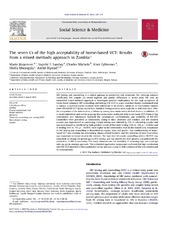| dc.contributor.author | Jürgensen, Marte | en_US |
| dc.contributor.author | Sandøy, Ingvild Fossgard | en_US |
| dc.contributor.author | Michelo, Charles Cheembo | en_US |
| dc.contributor.author | Fylkesnes, Knut Martin | en_US |
| dc.contributor.author | Mwangala, Sheila | en_US |
| dc.contributor.author | Blystad, Astrid | en_US |
| dc.date.accessioned | 2015-04-10T06:56:28Z | |
| dc.date.available | 2015-04-10T06:56:28Z | |
| dc.date.issued | 2013-11 | eng |
| dc.identifier.issn | 0277-9536 | |
| dc.identifier.uri | https://hdl.handle.net/1956/9741 | |
| dc.description.abstract | HIV testing and counselling is a critical gateway to prevention and treatment. Yet, coverage remains insufficient, few couples are tested together and gender differences in access exist. We used an embedded mixed methods approach to investigate possible explanations for the high acceptance of home-based voluntary HIV counselling and testing (HB-VCT) in a pair-matched cluster-randomized trial in Zambia. A baseline survey included 1694 individuals in 36 clusters. Adults in 18 intervention clusters were offered HB-VCT by lay counsellors. Standard testing services were available in both trial arms. After the completion of the intervention, a follow-up survey was conducted in all trial clusters. In addition, 21 in-depth interviews and one focus group discussion were conducted with home-based VCT clients in the intervention arm. Informants favoured the convenience, confidentiality and credibility of HB-VCT. Counsellors were perceived as trustworthy owing to their closeness and conduct, and the consent process was experienced as convincing. Couple testing was selected by 70% of cohabiting couples and was experienced as beneficial by both genders. Levels of first-time testing (68% vs. 29%, p < 0.0001) and re-testing (94% vs. 74%, p < 0.0001) were higher in the intervention than in the control arm. Acceptance of HIV testing and counselling is dependent on stigma, trust and gender. The confidentiality of home-based VCT was essential for overcoming stigma-related barriers, and the selection of local counsellors was important to ensure trust in the services. The high level of couple counselling within HB-VCT may contribute to closing the gender gap in HIV testing, and has benefits for both genders and potentially for prevention of HIV transmission. The study demonstrates the feasibility of achieving high test coverage with an opt-in consent approach. The embedded qualitative component confirmed the high satisfaction with HB-VCT reported in the quantitative survey and was crucial to fully understand the intervention and its consequences. | en_US |
| dc.language.iso | eng | eng |
| dc.publisher | Elsevier | eng |
| dc.rights | Attribution-NonCommercial-NoDerivs CC BY-NC-ND | eng |
| dc.rights.uri | http://creativecommons.org/licenses/by-nc-nd/3.0/ | eng |
| dc.subject | Sub-Saharan Africa | eng |
| dc.subject | Zambia | eng |
| dc.subject | Cluster-randomized trial | eng |
| dc.subject | Mixed methods | eng |
| dc.subject | HIV/AIDS | eng |
| dc.subject | Voluntary counselling and testing (VCT) | eng |
| dc.subject | Home-based testing | eng |
| dc.subject | Gender | eng |
| dc.title | The seven Cs of the high acceptability of home-based VCT: Results from a mixed methods approach in Zambia | en_US |
| dc.type | Peer reviewed | |
| dc.type | Journal article | |
| dc.date.updated | 2015-04-01T08:19:14Z | en_US |
| dc.description.version | publishedVersion | en_US |
| dc.rights.holder | Copyright 2013 The Authors | |
| dc.identifier.doi | https://doi.org/10.1016/j.socscimed.2013.07.033 | |
| dc.identifier.cristin | 1099274 | |
| dc.source.journal | Social Science and Medicine | |
| dc.source.40 | 97 | |
| dc.source.pagenumber | 210-219 | |

